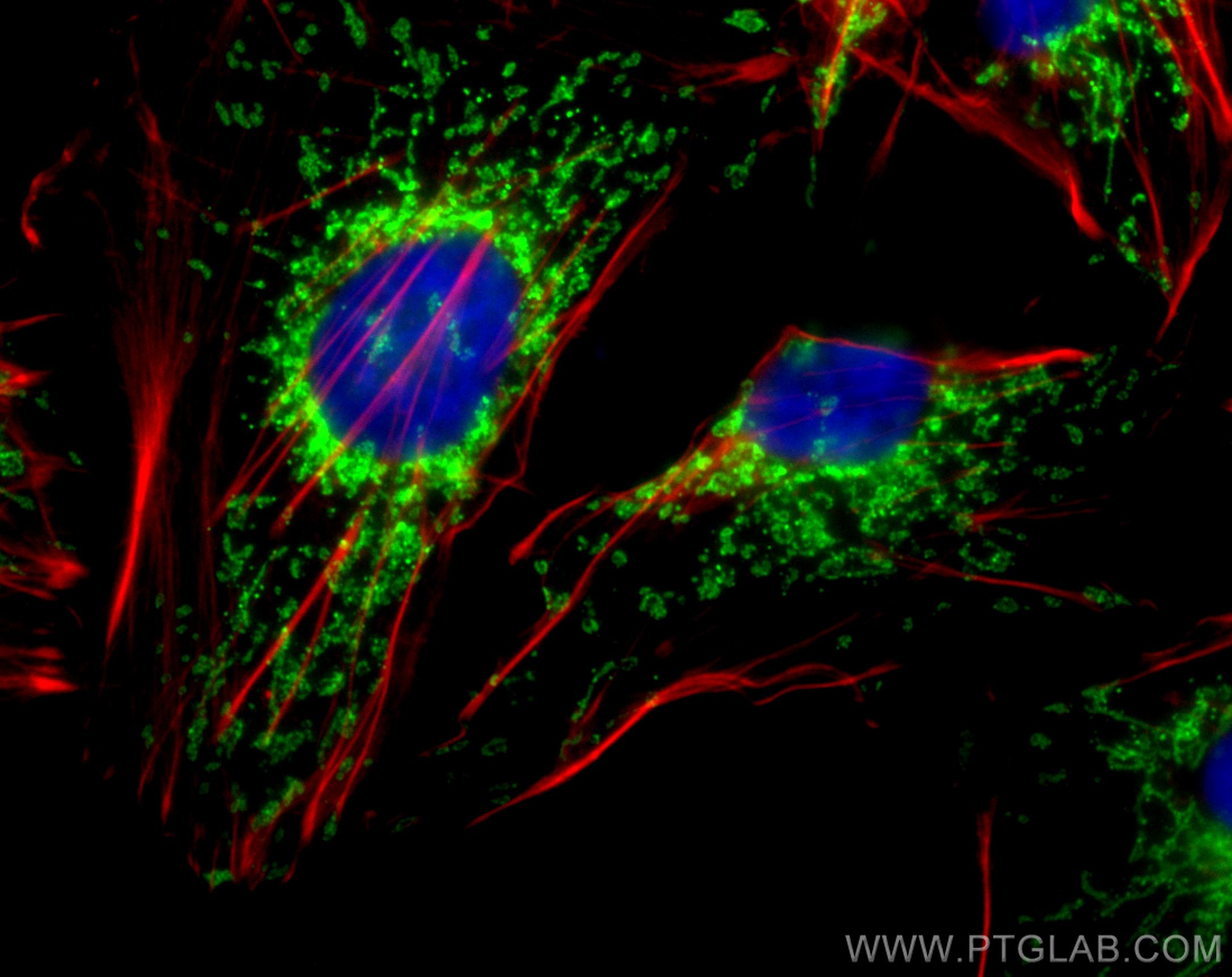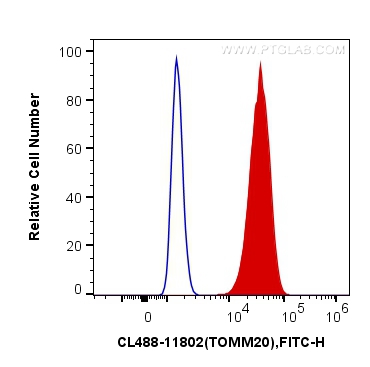- Featured Product
- KD/KO Validated
CoraLite® Plus 488-conjugated TOM20 Polyclonal antibody
TOM20 Polyclonal Antibody for FC (Intra), IF/ICC
Host / Isotype
Rabbit / IgG
Reactivity
human, mouse, rat
Applications
FC (Intra), IF/ICC
Conjugate
CoraLite® Plus 488 Fluorescent Dye
验证数据展示
经过测试的应用
| Positive IF detected in | HUVEC cells |
| Positive FC detected in | HeLa cells |
推荐稀释比
| Application | Dilution |
|---|---|
| Immunofluorescence (IF) | IF : 1:50-1:500 |
| Flow Cytometry (FC) | FC : 0.40 ug per 10^6 cells in a 100 µl suspension |
| It is recommended that this reagent should be titrated in each testing system to obtain optimal results. | |
| Sample-dependent, Check data in validation data gallery. | |
发表文章中的应用
| IF | See 3 publications below |
产品信息
CL488-11802 targets TOM20 in IF, FC (Intra) applications and shows reactivity with human, mouse, rat samples.
| Tested Applications | FC (Intra), IF/ICC |
| Cited Applications | IF |
| Tested Reactivity | human, mouse, rat |
| Cited Reactivity | human, mouse |
| Immunogen | TOM20 fusion protein Ag2378 种属同源性预测 |
| Host / Isotype | Rabbit / IgG |
| Class | Polyclonal |
| Type | Antibody |
| Full Name | translocase of outer mitochondrial membrane 20 homolog (yeast) |
| Synonyms | KIAA0016, MAS20, Mitochondrion Marker, MOM19, TOM20, TOMM20 |
| Calculated Molecular Weight | 145 aa, 16 kDa |
| Observed Molecular Weight | 16 kDa |
| GenBank Accession Number | BC000882 |
| Gene Symbol | TOMM20 |
| Gene ID (NCBI) | 9804 |
| RRID | AB_2919040 |
| Conjugate | CoraLite® Plus 488 Fluorescent Dye |
| Excitation/Emission Maxima Wavelengths | 493 nm / 522 nm |
| Form | Liquid |
| Purification Method | Antigen affinity purification |
| UNIPROT ID | Q15388 |
| Storage Buffer | PBS with 50% Glycerol, 0.05% Proclin300, 0.5% BSA, pH 7.3. |
| Storage Conditions | Store at -20°C. Avoid exposure to light. Aliquoting is unnecessary for -20oC storage. |
背景介绍
Background
TOM20 (KIAA0016) belongs to the Tom family. It is a subunit of the mitochondrial import receptor (PMID: 7584026), whose main role is to translocate cytosolically synthesized mitochondrial proteins through the outer mitochondrial membrane and subsequently facilitate the movement of proteins into the TOM40 translocation pore complex (PMID: 21173275).
What is the molecular weight of TOM20?
It is a short 16.3 kDa protein containing several highly conserved regions, including the transmembrane segment, the ligand-binding domain, and flexible segments at the N terminus and the C terminus of the protein crucial for its function (PMID: 15733919).
What is the subcellular localization of TOM20?
It specifically localizes in the mitochondrial outer membrane. In malignant cells, strong granular staining in the cytoplasm has been observed.
What is the tissue specificity of TOM20?
It is ubiquitously expressed in various tissues, with a particularly high expression in the brain, thyroid, and pancreas.
What is the function of TOM20 in the mitochondrial membrane?
Mitochondrial preproteins are generally synthesized in the cytoplasm with signal or targeting sequences, which are recognized by specific receptors on the outer mitochondrial membrane. TOM20, as one of the components of the TOM40 complex, specifically recognizes pre-sequences on target proteins or their unfolded forms. In addition to its translocase activity, TOM20 may act as a chaperone preventing these proteins from aggregation at the surface of mitochondria (PMID: 14699115).
What is TOM20's involvement in disease?
Diseases linked to the misregulation of TOM20 include Perry Syndrome and neurodegeneration with brain iron accumulation 2A. Numerous studies also associate deregulation of TOM20 with an array of mitochondrial dysfunctions and mitophagy defects (PMIDs: 30254015, 30160596).
实验方案
| Product Specific Protocols | |
|---|---|
| IF protocol for CL Plus 488 TOM20 antibody CL488-11802 | Download protocol |
| FC protocol for CL Plus 488 TOM20 antibody CL488-11802 | Download protocol |
| Standard Protocols | |
|---|---|
| Click here to view our Standard Protocols |
发表文章
| Species | Application | Title |
|---|---|---|
Free Radic Biol Med Loss of the redox mitochondrial protein mitoNEET leads to mitochondrial dysfunction in B-cell acute lymphoblastic leukemia. | ||
bioRxiv Integrated spatial transcriptomics and lipidomics of precursor lesions of pancreatic cancer identifies enrichment of long chain sulfatide biosynthesis as an early metabolic alteration | ||
iScience Lipopolysaccharide induces placental mitochondrial dysfunction in murine and human systems by reducing MNRR1 levels via a TLR4-independent pathway |


